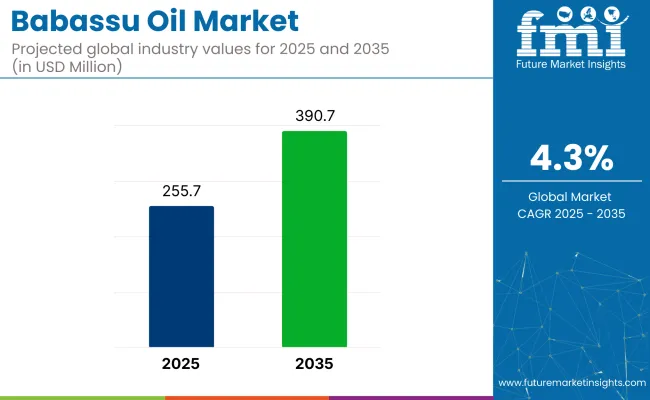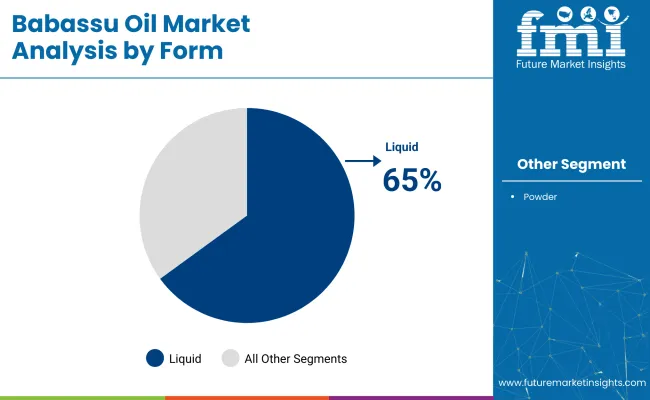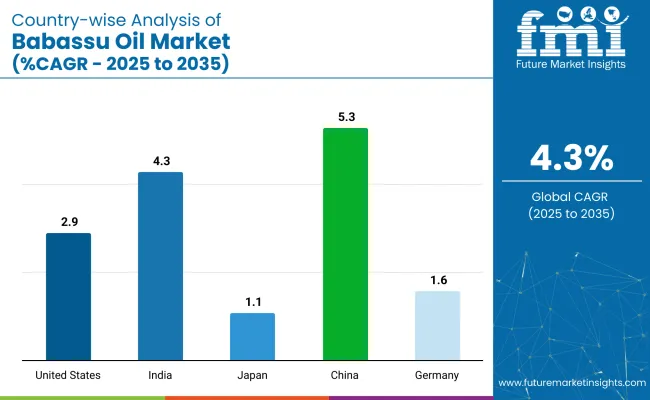The babassu oil market is projected to reach a value of USD 255.7 million in 2025 and is expected to grow significantly to USD 390.7 million by 2035, reflecting a steady CAGR of 4.3%. This growth trajectory is largely driven by the increasing adoption of Babassu oil across various industries such as cosmetics, personal care, food, and pharmaceuticals.

| Metric | Value |
|---|---|
| Market Size (2025E) | USD 255.7 million |
| Market Value (2035F) | USD 390.7 million |
| CAGR (2025 to 2035) | 4.3% |
The oil's natural properties, including its emollient, antimicrobial, and anti-inflammatory characteristics, position it as a highly versatile ingredient for numerous applications. Its emergence as a sustainable, eco-friendly alternative to traditional oils, particularly in the beauty and wellness sectors, further strengthens its market potential.Governments are also investing in sustainable products. In January 2025, USDA announced nearly USD 180 million in funding under the REAP and Higher Blends Infrastructure program.
The market holds a niche yet important share within its parent markets. Within the vegetable oil market, Babassu oil accounts for a small percentage, approximately 1-2%, as it is one of many specialty oils produced. In the broader natural oil market, it holds a more significant share of about 3-5%, as demand for plant-based and natural oils continues to grow.
In the cosmetic and personal care market, theyplay a more prominent role, contributing roughly 5-7% due to its moisturizing and skin-nourishing properties. In the pharmaceutical ingredients market, its share is around 2-3%, used primarily in topical formulations. Lastly, in the food & beverage market, thesescontributes 1-2%, utilized for its health benefits and as a natural alternative to other oils.
One of the primary factors driving the market is the growing global trend toward sustainable and clean-label products. With consumers becoming more environmentally conscious and health-focused, there is a clear preference for natural and responsibly sourced ingredients in cosmetics and personal care products. Babassu oil, sourced primarily from Brazil and other parts of Southeast Asia, aligns well with this demand, as it is known for being harvested in a sustainable manner, often by women-led cooperatives.
This focus on ethical sourcing resonates with the increasing number of consumers seeking fair-trade, cruelty-free, and eco-friendly beauty products. Brands like Dr. Bronner's and L'Occitane have already embraced product in their product lines, contributing to its rising popularity in skincare formulations.
The babassu oil market is segmented by form into liquid and solid. By end use, it includes cosmetics and personal care, food and beverages, and industrial applications. By nature, the market is categorized into organic and conventional.
Distribution takes place through pharmacies, specialty stores, supermarkets and hypermarkets, and online retail. The market is regionally segmented into North America, Latin America, Europe, East Asia, South Asia & Pacific, and the Middle East & Africa.
Cosmetic and personal care products are expected to account for 54.1% of global babassu oil consumption by 2025. This segment dominates due to the oil’s fast-absorbing, non-greasy profile, which makes it a core emollient in moisturizers, cleansers, shampoos, and hair masks.

Organic babassu oil is projected to contribute 39.7% of total sales in 2025, driven by a global rise in demand for pesticide-free, sustainably harvested ingredients in both cosmetics and food-grade products.
Liquid babassu oil is expected to maintain 65% of global share by 2025, supported by its utility across manufacturing processes and ease of consumer use.

Pharmacy and drugstore outlets are forecast to contribute 45% of global babassu oil retail sales in 2025. Their stronghold stems from customer trust in therapeutic and dermatologist-recommended personal care.
The market is driven by growing demand for natural, sustainable skincare solutions and its positioning as a clean-label alternative to coconut oil. E-commerce expansion and product innovation have further boosted its visibility, with diverse applications across beauty, wellness, and food sectors.
Key Market Dynamics Driving Babassu Oil Growth
The global market is being significantly influenced by the rising demand for natural and organic personal care products, with consumer preferences increasingly shifting toward clean-label, chemical-free alternatives.
This shift has been fueled by heightened awareness of ingredient transparency and the benefits of plant-based oils, particularly in skincare and haircare. Babassu oil, often seen as a sustainable substitute for coconut oil, is being valued for its moisturizing properties, lightweight texture, and non-comedogenic nature. The perception of product as both therapeutic and cosmetic has been further strengthened by its inclusion in premium formulations and dermatologist-recommended products.
E-commerce Expansion and Innovation in Product Applications
The market has also been reshaped by the rapid expansion of e-commerce platforms and the growing accessibility of specialty oils online. A wider audience is being reached through digital retailing, where product is marketed under terms like "virgin babassu oil," "refined babassu oil," and "organic carrier oil."
The online retail environment enables niche brands and DIY-focused consumers to explore product for uses beyond personal care, such as in aromatherapy, massage therapy, and food applications. These diverse use-cases, supported by influencer marketing and social proof, have amplified product’s visibility and boosted its sales momentum across regions.

| Countries | CAGR (2025 to 2035) |
|---|---|
| United States | 2.9% |
| India | 4.3% |
| Japan | 1.1% |
| China | 5.3% |
| Germany | 1.6% |
Sales of babassu oil across key countries are forecast to rise steadily, with China leading at a CAGR of 5.3%, followed by India at 4.3%, reflecting strong personal care demand and rapid retail channel expansion. The United States grows at 2.9%, driven by clean beauty trends, while Germany (1.6%) and Japan (1.1%) report slower but steady growth rooted in premiumization and eco-label preferences.
These rates deliver a growth premium of +1.6 to +3.8 percentage points above the Western European average, with BRICS markets (China and India) delivering higher unit volume gains, while OECD countries (US, Germany, Japan) prioritize ingredient purity and traceability.
China exceeds Western Europe’s growth average by +3.7 points, supported by e-commerce integration and domestic skincare innovation. India outpaces by +2.7 points, driven by consumer shift toward plant-based oils and ayurveda-backed beauty formats. USA maintains a +1.3-point premium, reflecting clean-label demand across retail channels.Germany and Japan hold steady, with a 0.0-0.2 point variance from broader OECD trends.
Demand for babassu oil in the United States is projected to grow at a 2.9% CAGR during the forecast period, driven by the increasing consumer preference for natural, organic products across personal care and beauty sectors. With a growing emphasis on clean beauty and sustainable ingredients, product is being increasingly incorporated into skincare, haircare, and cosmetics formulations.
As awareness around the benefits of plant-based oils like babassu grows, the market is witnessing a surge in demand for this versatile, non-comedogenic oil, especially in high-end, eco-conscious products. The USA is also experiencing a rise in health-conscious consumers who are actively avoiding synthetic chemicals and opting for organic and natural alternatives, further bolstering the demand for babassu oil.
The babassu oil market in China is estimated to grow at a 5.3% CAGR during the forecast period, as the country continues to see rapid growth in the natural and organic beauty markets. With amanufacturing and cosmetics industry, the product is becoming a key ingredient in a variety of skincare and haircare products.
The market growth is further driven by the growing awareness among Chinese consumers about the harmful effects of synthetic chemicals and their increasing preference for natural oils. Babassu oil is valued for its lightweight, moisturizing properties and non-greasy texture, making it highly attractive to Chinese consumers seeking gentle, effective beauty products. The rise of e-commerce platforms in China has made it easier for consumers to access international, high-quality beauty products containing product.
The babassu oil market in Japan is likely to grow at a 1.1% CAGR during the forecast period, influenced by the country’s growing preference for natural and multifunctional beauty products. The Japanese skincare market has long been known for its focus on purity and efficacy, and babassu oil’s reputation for moisturizing and soothing properties has made it a valuable ingredient in cosmetics and personal care products.
The country’s aging population and heightened interest in anti-aging skincare have also contributed to the rising demand for natural oils like babassu. Furthermore, Japan's sustainability initiatives and its commitment to eco-friendly ingredients have positioned product as an attractive alternative to synthetic oils in beauty formulations, driving its growth in the Japanese market.
The babassu oil market in Germany is expected to grow at a 1.6% CAGR during the forecast period, supported by the country’s strong emphasis on sustainability, eco-friendly products, and organic beauty solutions. Germany is a key player in the European natural beauty and personal care industry, and consumers are increasingly choosing products that contain ingredients like babassu oil, which are sustainably sourced and free from harmful chemicals.
The German market’s growing interest in organic cosmetics and natural oils has driven demand for product, particularly in skincare, haircare, and wellness products. Furthermore, Germany’s regulatory environment, which promotes the use of natural ingredients in cosmetics, has created a favorable landscape for product to thrive.
The babassu oil market in India is likely to grow at a 4.3% CAGR during the forecast period, propelled by the country’s increasing interest in organic and natural beauty solutions. India’s rapidly expanding middle class, coupled with rising disposable incomes, has led to a greater demand for high-quality, natural personal care products. Babassu oil’s multifunctional properties, including its ability to moisturize, nourish, and protect skin and hair, have contributed to its rising popularity among Indian consumers.
The increasing adoption of plant-based, chemical-free ingredients in beauty products has paved the way for market growth. The growing trend toward eco-conscious, sustainable products, along with India’s vast agricultural sector, is helping drive both domestic and international demand for product.
The industry is driven by established players and emerging innovators focused on natural oils, sustainable beauty products, and organic ingredients. Key companies like Akzo Nobel, Solvay, and BASF lead with advanced chemical solutions and sustainable sourcing, while Cargill and Bunge have made strides in the natural oils market, offering high-quality product for personal care and food applications.
Mielle Organics and ANITA GRANT are prominent innovators in the beauty sector, formulating luxurious, organic skincare and haircare products with babassu oil. In the niche natural beauty space, Sheabutter Cottage and Dr. Adorable Inc. are known for their eco-conscious formulations, blending product into their offerings to cater to health-conscious consumers. These key players, alongside the rising focus on clean beauty and sustainable sourcing, are driving the growth in global markets.
Recent Babassu Oil Industry News
| Report Attributes | Details |
|---|---|
| Market Size (2025) | USD 255.7 million |
| Projected Market Size (2035) | USD 390.7 million |
| CAGR (2025 to 2035) | 4.3% |
| Base Year for Estimation | 2024 |
| Historical Period | 2020 to 2024 |
| Projections Period | 2025 to 2035 |
| Quantitative Units | USD million for value and volume in kilo tons |
| Type Analyzed (Segment 1) | Conventional and Organic |
| Form Analyzed (Segment 2) | Powder and Liquid. |
| Applications Analyzed (Segment 3) | Food & Beverage, Pharmaceutical, and Cosmetics. |
| Sales Channel Analyzed (Segment 4) | Pharmacy, Beauty Salon, Specialty Stores, and Online Retailing. |
| Regions Covered | North America, Europe, Asia Pacific, Middle East & Africa, Latin America |
| Countries Covered | United States, Canada, Germany, United Kingdom, France, Italy, Spain, China, Japan, South Korea, India, Australia, Brazil, Mexico, Argentina, Saudi Arabia, UAE, South Africa |
| Key Players | Akzo Nobel, Solvay, BASF, Mielle Organics, Cargill, Bunge, Dow Chemical, Sheabutter Cottage, Dr. Adorable Inc., ANITA GRANT. |
| Additional Attributes | Dollar sales projections, market share by region and application, growth rates across segments (cosmetics, food, etc.), competitor strategies, demand trends, pricing analysis, distribution channels, regulatory insights, and consumer preferences. |
The industry is segmented conventional and organic.
The key forms include powder and liquid.
The industry finds applications in food & beverage, pharmaceutical, and cosmetics.
The segment is divided into pharmacy, beauty salon, specialty stores, and online retailing.
The industry covers regions including North America, Europe, Asia Pacific, Latin America, and the Middle East & Africa.
The industry is valued at USD 255.7 million in 2025.
It is forecasted to reach USD 390.7 million by 2035.
The industry is anticipated to grow at a CAGR of 4.3% during this period.
Liquid forms are projected to lead the market with a 65% share in 2025.
Asia Pacific, particularly China, is expected to be the key growth region with a projected growth rate of 5.3%.






Full Research Suite comprises of:
Market outlook & trends analysis
Interviews & case studies
Strategic recommendations
Vendor profiles & capabilities analysis
5-year forecasts
8 regions and 60+ country-level data splits
Market segment data splits
12 months of continuous data updates
DELIVERED AS:
PDF EXCEL ONLINE
Oily Waste Can Market Size and Share Forecast Outlook 2025 to 2035
Oil and Gas Seal Market Size and Share Forecast Outlook 2025 to 2035
Oil Coalescing Filter Market Size and Share Forecast Outlook 2025 to 2035
Oil-immersed Iron Core Series Reactor Market Size and Share Forecast Outlook 2025 to 2035
Oil and Gas Sensor Market Forecast Outlook 2025 to 2035
Oil Packing Machine Market Forecast and Outlook 2025 to 2035
Oil and Gas Pipeline Coating Market Forecast and Outlook 2025 to 2035
Oilfield Scale Inhibitor Market Size and Share Forecast Outlook 2025 to 2035
Oil-in-Water Anionic Emulsifier Market Size and Share Forecast Outlook 2025 to 2035
Oil and Gas Field Services Market Size and Share Forecast Outlook 2025 to 2035
Oil Control Shampoo Market Size and Share Forecast Outlook 2025 to 2035
Oil Expellers Market Size and Share Forecast Outlook 2025 to 2035
Oilfield Stimulation Chemicals Market Size and Share Forecast Outlook 2025 to 2035
Oiler Kits Market Size and Share Forecast Outlook 2025 to 2035
Oil Pressure Sensor Market Size and Share Forecast Outlook 2025 to 2035
Oil Filled Power Transformer Market Size and Share Forecast Outlook 2025 to 2035
Oily Skin Control Products Market Analysis - Size and Share Forecast Outlook 2025 to 2035
Oil Immersed Shunt Reactor Market Size and Share Forecast Outlook 2025 to 2035
Oil Country Tubular Goods Market Size and Share Forecast Outlook 2025 to 2035
Oil Filled Distribution Transformer Market Size and Share Forecast Outlook 2025 to 2035

Thank you!
You will receive an email from our Business Development Manager. Please be sure to check your SPAM/JUNK folder too.
Chat With
MaRIA